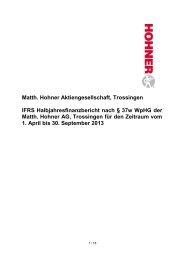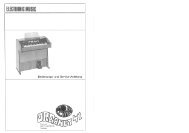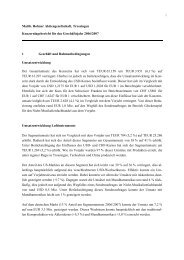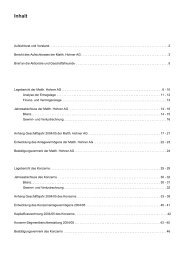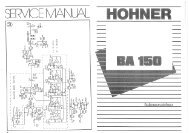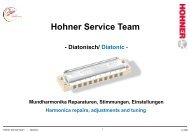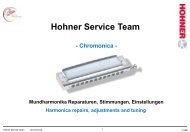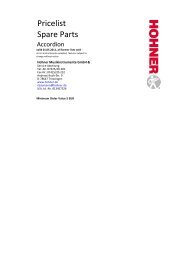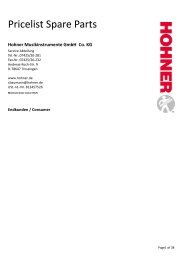Matth. Hohner AG
Matth. Hohner AG
Matth. Hohner AG
You also want an ePaper? Increase the reach of your titles
YUMPU automatically turns print PDFs into web optimized ePapers that Google loves.
Notes to the Consolidated Financial Statements for Business Year 2010/2011<br />
The table below shows the reconciliation between the income tax expense and the product of the net profit<br />
for the period and the applicable tax rate of the Group for the business years 2010/2011 and 2009/2010:<br />
2010/2011 2009/2010<br />
TEUR TEUR<br />
Result before income taxes 2,003 2,245<br />
Income tax expense at the tax rate in Germany of 28.425 %<br />
(prior year: 28.425 %)<br />
569 638<br />
Adjustments of current income taxes incurred in prior years -289 370<br />
Non-deductible expenses 23 22<br />
Tax-free income, other deductibles and permanent differences -45 -67<br />
Other 16 25<br />
Effect of the local tax rate on the deferred tax rate of the Group<br />
(including follow-on effect in consolidation)<br />
53 78<br />
Non-recognition or adjustment of unused tax losses 191 336<br />
Income tax expenses (+)/income (-) disclosed<br />
in the consolidated income statement<br />
518 1,402<br />
21. Earnings per share<br />
When calculating earnings per share, the net income allocable to the shareholders of the parent entity of<br />
TEUR 1,484 (prior year: TEUR 843) is divided by the weighted average number of common shares outstanding<br />
(3,000,000). The earnings per share for business year 2010/2011 are EUR 0.49 (prior year: EUR 0.28).<br />
There are no dilutive effects.<br />
22. Financial instruments – Risk management<br />
Basic principles of risk management<br />
The hedging strategy and risk factors of the financial instruments are determined by type of risk. Necessary<br />
hedging measures are arranged locally by the individual Group entities and monitored centrally.<br />
The risk policy of HOHNER Group is designed to responsibly and equitably balance the opportunities and risks<br />
of entrepreneurial when acting against each other. The risk management is an integral part of the planning<br />
and controlling process. Our overall goals are to secure the Group’s assets as well as increase of shareholder<br />
value. The strategies of the Group aim at the optimal use of opportunities given and limiting the risks<br />
associated with business activity to the greatest extent possible.<br />
Risk management of HOHNER Group<br />
An extensive risk management system continuously assesses and monitors the development of the company<br />
as well as current weaknesses, risks and chances.<br />
The system of risk management comprises all business areas and includes reporting as a central element.<br />
This enables group management to act fast and effective. There are risk representatives and risk reporters<br />
for every part of the group to ensure the implementation of the reporting process. The reporting process<br />
divides risks into categories, reports by these categories and then assesses the possibilities of occurrence<br />
and the possible outcomes measured in monetary units. The system is based on individual observations,<br />
supported by adequate management processes, and is integrated into the core activities. It starts with<br />
strategical planning and continues with procurement and sales including accounts receivable management. As<br />
extension to the planning process in the business units, the procurement and sales organization as well as the<br />
corporate functions, the system for risk management functions to identify and assess possible deviations from<br />
expected developments. In addition to the identification and assessment of material developments, which<br />
influence business activity, the system is designed to prioritize and implement activities. As a consequence<br />
there is a better way to make use of chances and to reduce risks. The business units provide risk reports<br />
on a regular basis. These risk reports are a core element of the risk management system. The reports are<br />
subject to the assessment of management and the persons in charge of the business units. The systematic<br />
further development of existing and new systems for early warnings significantly contributes to the further<br />
consolidation and to the projected development of the company-wide culture of risks.<br />
The basic principles of the Group’s system for the identification and monitoring of risks, specific to the<br />
company’s business are described in a guideline to risk management, approved by management.<br />
The explanations to the risks are realigned to IFRS 7, which divides risks to credit risks, liquidity risks and<br />
market risks. The explanations are complemented by further risks.<br />
Notes to the CoNsolidated FiNaNCial statemeNts Notes to the CoNsolidated FiNaNCial statemeNts<br />
105



